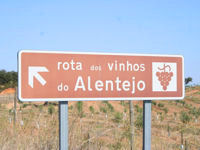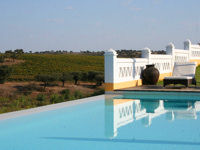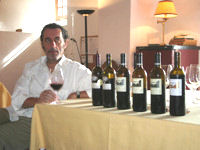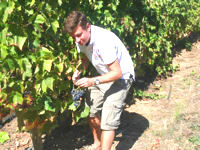The Alentejo: Portugal’s undiscovered wine region
Unpretentious, unhurried and relatively unknown as a tourism hub, the Alentejo in Portugal makes the perfect wine lovers’ getaway, says Jonny Payne.
The land is flat for as far as the eye can see as we make our descent into Beja Airport in the specially chartered 48-seater aircraft. The scattered cork trees punctuate the landscape like a handful of drawing pins dropped from a great height onto the parched yellow grass below. This is the Alentejo, one of Portugal’s lesser-known regions, but an area that’s rapidly making a name for itself in the wine world.
Despite being a relatively new wine region, the Alentejo has long been involved in the industry. After all, the cork used for bottling has been sourced from this very area for decades. And while the new wineries of Portugal’s largest region are only now starting to make their mark, viticulture has actually been present since the Romans set foot on the fertile soil.
Why visit the Alentejo?
 Follow the wine route between the numerous vineyards
Follow the wine route between the numerous vineyardsWTG / Jonny Payne
As my partner and I drive along the straight, empty roads between the various villages, vineyards and wineries on our Sunvil Discovery self-drive tour, we quickly realise this rural region has a very earthy and comforting feel.
The locals welcome us warmly wherever we go, while the food is comforting too, with hearty stews and casseroles. The delicious sopa de cação – a coriander- and garlic-based soup with chunks of meaty dogfish, sheep’s cheese and poached eggs, ladled generously over a bed of bread – is the standout dish. Pork and lamb stews, rabbit salads and sticky egg-based desserts are other local delicacies.
There are also plenty of attractions here, from the stunning, medieval hilltop town of Monsaraz and the narrow, winding streets of UNESCO World Heritage site Évora, to the watersports haven of the dammed Alqueva Lake.
And then there’s the wine…
Wines of the Alentejo
 Sample the full range of wines at the Alentejo's wineries
Sample the full range of wines at the Alentejo's wineriesWTG / Jonny Payne
The wine in the Alentejo is distinct from that of Portugal’s more northerly Douro region, which is famed for its fortified port wine. Here, the hot, dry climate allows for an intensity of flavours and high alcohol content characterised in full-bodied reds and aromatic whites.
Limestone soils prevail in the southern areas, chalky soils are found in the terroir around Évora, while marble chips dominate the soils of Estremoz. This creates distinct variations in the wines between the eight Alentejo DOC (designated controlled origin) subregions.
As we learn during our short time in the Alentejo, wines here are mostly composed of blends of native and introduced grape varieties, which allows for everything from easy drinking wines to robust alternatives. The whites, for example, can have either heavy oak-dominated profiles or fresh, tropical fruit overtones.
But red wine dominates here. Among the local grape varieties, Alicante Bouschet is notable for its rich, crimson colour, while Aragonês, Touriga Nacional and Trincadeira give red fruit and plum flavours. The few white varieties include Antão Vaz and Roupeiro, which their tropical fruit aromas, and Arinto with its citrus-dominated profiles.
Stay in the Alentejo’s vineyards
 Stay at the luxurious Herdade do Sobroso
Stay at the luxurious Herdade do SobrosoWTG / Jonny Payne
If just tasting the wine isn’t enough, try staying in the various vineyards with on-site accommodation, ranging from family-friendly complexes to opulent, isolated hideaways.
The five-room, five-apartment Herdade do Sobroso near Vidigueira certainly falls into the latter category. Overlooking the dammed Guadiana River, this estate is a veritable haven of tranquillity, where even a few electricity pylons fail to detract from the most relaxing of landscapes.
Our affable host Jorge takes us on a ‘safari’ through a setting that’s not too dissimilar to the African savannah. With no lions to see, we’re soon spotting scampering partridges, which can be hunted by guests. We emerge at the top of the hill to the incredible sight of the river, before returning to a delicious meal conjured up by resident cook Josefa. She treats us to fine examples of traditional Alentejo cuisine, including black pig in vinegar, stuffed field mushrooms and sopa de cação.
Herdade do Sobroso produces 200,000 bottles per year and friendly oenologist Filipe talks us through the various wines – my pick is the Herdade do Sobroso 2008 red with a mellow, red fruits palate and a plummy nose.
The Hotel Vila Galé Clube de Campo, meanwhile, provides an affordable, family-friendly alternative, with activities and a spa offering therapy treatments using wine-based products. I try the latter, and after being exfoliated, heat wrapped and massaged over the course of a few hours, I’m thoroughly relaxed and ready for another bout of wine tasting at the adjacent Santa Vittoria winery.
A truly lavish option is the elegant 5-star Convento do Espinheiro, a former convent in the charming walled town of Évora. It does not currently produce its own wine, but it more than makes up for it with a well-stocked cellar – the perfect venue for its evening wine tastings.
Wineries in the Alentejo
 Miguel Louro, the passionate owner of Quinta do Mouro
Miguel Louro, the passionate owner of Quinta do MouroWTG / Jonny Payne
Most wineries in the Alentejo prefer to simply concentrate on the wine itself.
One such place is Quinta do Mouro in Estremoz, which has just 27 hectares (67 acres) of vines. We have the pleasure of meeting its owner, Miguel Louro; a tall, slightly wiry sixty-something man who’s a truly captivating character. Over the course of three hours, we try a number of wines, more classical in style than others we have previously sampled. The rich, chocolaty Quinta do Mouro 2006 is extremely moreish, while the Quinta do Mouro Gold Label 2007 is the pick of the wines I have tasted in the Alentejo. Given its intense nose and robust palate, it’s definitely a wine drinkers’ wine to be savoured slowly.
Clearly enjoying the company, Miguel opens more bottles until we regrettably have to move on. But that’s not before he’s shown us his wine cellar, which while rudimentary compared to the modern, thermostat-controlled cellars of other wineries, works perfectly due to the old-fashioned construction methods. Even the production process here is traditional, with the use of Portuguese oak, no irrigation, and the treading of the grapes by foot only.
The renowned Herdade do Esporão in Reguengos Monsaraz is a different operation altogether. Having eventually found the obscurely signposted turning from the town centre, we arrive at the largest private winery in the region, which produces 8 million litres (1.75 million gallons) of 20 different wines each year. And we’re about to sample what seems like a large percentage of that total.
Aided by Sandra, the resident oenologist, we try a number of wines before sitting down to a wonderful lunch consisting of a five-course meal and six different wines. It’s a pleasure to try these alongside the wonderful local cuisine, which complements the wine seamlessly.
 Harvest grapes at Monte da Ravasqueira
Harvest grapes at Monte da RavasqueiraWTG / Jonny Payne
Other worthwhile stops include the vast cooperative Carmim in Reguengos Monsaraz, the biggest winery in the region, where we taste fermenting wines straight from the vats, and Monte da Ravasqueira in Arraiolos. The latter is not only distinct in having a fascinating collection of antique horse-drawn carriages, but it’s also the only vineyard that is still harvesting during our visit (the grapes matured surprisingly quickly this year due to the intense day and night-time temperatures). Much to my delight, I’m given a chance to harvest grapes, which brings the tour neatly to an end, having experienced the whole process from the field to the table.
The Alentejo is a wonderful place to learn about wine, or, (if you’re already a connoisseur) to experience an emerging, character-filled and unpretentious wine region – you’ll be surprised how much you can learn in a few days in this welcoming region.
The writer’s choice:
• Quinta do Mouro Gold Label 2007 (Quinta do Mouro) – My favourite, a classical red with a deep colour, intense nose and robust palate. Made from the season’s best grapes.
• Malhadinha 2008 (Herdade da Malhadinha Nova) – This red has robust aromas with vanilla and chocolate overtones. The label is decorated with a cow, drawn by one of the family’s children.
• Garrafeira dos Socios 2004 (Carmim) - A rich, mellow red with dark fruit aromas, perfect with game.
• Herdade Grande Rosé 2010 (Herdade Grande) – An unusually fresh wine from the region with summer fruits flavours.
• Monte da Ravasqueira Flavours 2010 (Monte da Ravasqueira) – A limited-range rosé with intense raspberry and plum overtones, sadly only sold at the estate.
• Arco 2010 (Herdade do Esporão) – A good entry-level white with peach and pineapple overtones, available in Waitrose, which also sells the fruity red in the same range.
Do you have any Feedback about this page?
© 2025 Columbus Travel Media Ltd. All rights reserved. No part of this site may be reproduced without our written permission, click here for information on Columbus Content Solutions.









 You know where
You know where